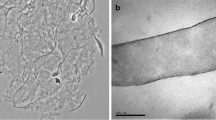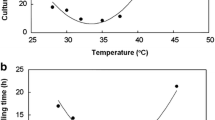Summary
A new hydrogen bacterium has been isolated by enrichment culture on hydrogen, carbon dioxide, and oxygen. It is a strictly aerobic, Gram-positive, immotile rod. Irregular cell shapes, the snapping type of cell division and the partial fragmentation of the rods into coccoid cells in older heterotrophic cultures indicate that strain 14 g is a coryneform bacterium.
Strain 14 g grows well in a mineral salts medium under a gas atmosphere of 80% hydrogen, 10% carbon dioxide and 10% oxygen. With increasing oxygen partial pressures, the growth rate decreases. While growth is good or excellent on organic acids, carbohydrates are utilized not at all.
Autotrophically grown cells are able to oxidize organic substrates after a relatively short lag-phase. Growth is retarded when hydrogen is present in the gas atmosphere. Citrate utilization is even inhibited by hydrogen.
In gluconate grown cells gluconokinase, the enzymes of the Entner-Doudoroff system and a NAD-dependent 6-phosphogluconate dehydrogenase are present. All enzymes are inducible.
The uptake rate of the oxygen-hydrogen mixture by resting cells is very high and amounts to 2500 μl gas/mg protein·h. Carbon dioxide does not stimulate the oxyhydrogen-reaction. The hydrogenase activity of intact cells measured with methylene blue as a hydrogen acceptor is limited by the penetration of methylene blue into the cell. In cell-free extracts the hydrogen uptake rate amounts to 2260 μl H2/mg protein·h with methylene blue as H-acceptor. The hydrogenase of strain 14 g is a strictly inducible enzyme. It is completely part culate and does not reduce pyridime nucleotides.
Similar content being viewed by others
References
Aggag, M., Schlegel, H. G.: Studies on a gram-positive hydrogen-bacterium, Nocardia opaca strain 1 b. I. Description and physiological characterization. Arch. Mikrobiol. 88, 299–318 (1973)
Beisenherz, G., Bolze, H. J., Bücher, Th., Czok, R., Garbade, K. H., Meyer-Arendt, E., Pfleiderer, G.: Diphosphofructose-Aldolase, Phosphoglyzeraldehyd-Dehydrogenase, Milchsäure-Dehydrogenase, Glycerophosphat-Dehydrogenase und Pyruvat-Kinase aus Kaninchenmuskulatur in einem Arbeitsgang. Z. Naturforsch. 8 b, 555–577 (1953)
Bender, R.: Anreicherung und Charakterisierung der d-Gluconat-Dehydratase von Clostridium pasteurianum. Diss., Göttingen 1972
Blackkolb, F., Schlegel, H. G.: Katabolische Repression und Enzymhemmung durch molekularen Wasserstoff bei Hydrogenomonas. Arch. Mikrobiol. 62, 129–143 (1968a)
Blackkolb, F., Schlegel, H. G.: Regulation der Glucose-6-phosphat-Dehydrogenase aus Hydrogenomonas H 16 durch ATP und NADH2. Arch. Mikrobiol. 63, 177–196 (1968b)
Bowien, B.: Hexoseabbau und Pentosebiosynthese in Hydrogenomonas. Diss., Göttingen 1970
Cohen, S. S.: Gluconokinase. In: Methods in enzymology, S. P. Colowick, N. O. Kaplan, Eds., Vol. I, pp. 350–354. New York: Academic Press 1955
Cowan, S. T., Steel, K. J.: Manual for the identification of medical bacteria. Cambridge: University Press 1965
Davis, D. H., Doudoroff, M., Stanier, R. Y.: Proposal to reject the genus Hydrogenomonas: Taxonomic implications. Int. J. Syst. Bact. 19, 375–390 (1969)
Davis, D. H., Stanier, R. Y., Doudoroff, M.: Taxonomic studies on some gramnegative flagellated “hydrogen bacteria” and related species. Arch. Mikrobiol. 70, 1–13 (1970)
Eberhardt, U.: Über das Wasserstoff-aktivierende System bei Hydrogenomonas H 16. I. Verteilung der Hydrogenase-Aktivität auf zwei Zellfraktionen. Arch. Mikrobiol. 53, 288–302 (1966)
Eberhardt, U.: On chemolithotrophy and hydrogenase of a gram-positive knallgasbacterium. Arch. Mikrobiol. 66, 91–104 (1969)
Gottschalk, G.: Die Verwertung organischer Substrate durch Hydrogenomonas in Gegenwart von molekularem Wasserstoff. Biochem. Z. 341, 260–270 (1965)
Gottschalk, G., Eberhardt, U., Schlegel, H. G.: Verwertung von Fructose durch Hydrogenomonas H 16 (I). Arch. Mikrobiol. 48, 95–108 (1964)
Gould, A. R., May, B. K., Elliott, W. H.: Accumulation of messenger RNA for extracellular enzymes as a general phenomenon in Bacillus amyloliquefaciens. J. molec. Biol. 73, 213–219 (1973)
Kaserer, H.: Die Oxydation des Wasserstoffs durch Mikroorganismen. Zbl. Bakt., II. Abt. 16, 681–696 (1906)
Niklewski, B.: Über die Wasserstoffoxidation durch Mikroorganismen. J. wiss. Bot. 48, 113–142 (1910)
Pfennig, N., Lippert, K. D.: Über das Vitamin-B12-Bedürfnis phototropher Schwefelbakterien. Arch. Mikrobiol. 55, 245–256 (1966)
Probst, I., Schlegel, H. G.: Studies on a gram-positive hydrogen bacterium, Nocardia opaca strain 1 b. II. Enzyme formation and regulation under the influence of hydrogen or fructose as growth substrates. Arch. Mikrobiol. 88, 319–330 (1973)
Romanova, A. K., Doman, N. G.: Fixation products of labelled carbon dioxide in hydrogen bacteria in the course of chemosynthesis. Mikrobiologiya 29, 795–801 (1960)
Rudolph, R.: Kulturgefäße zur Anzucht von Hydrogenomonas H 16 mit elektrolytischer Knallgaserzeugung. Diss., Göttingen 1968
Schlegel, H. G., v. Bartha, R.: “Leerlauf”-H2-Oxydation und “Rückkoppelung” bei Knallgasbakterien. Naturwissenschaften 48, 414–415 (1961)
Schlegel, H. G., Kaltwasser, H., Gottschalk, G.: Ein Submersverfahren zur Kultur wasserstoffoxidierender Bakterien: Wachstumsphysiologische Untersuchungen. Arch. Mikrobiol. 38, 209–222 (1961)
Schmidt, K., Jensen, S. L., Schlegel, H. G.: Die Carotinoide der Thiorhodaceae. I. Okenon als Hauptcarotinoid von Chromatium okenii. Perty. Arch. Mikrobiol. 46, 117–126 (1963)
Siebert, D.: Über propanverwertende, wasserstoffoxidierende Bakterien und die Charakterisierung eines Förderungsfaktors. Diss., Göttingen 1969
Tunail, N., Schlegel, H. G.: Phosphoenolpyruvate, a new inhibitor of Glucose-6-phosphate dehydrogenase. Biochem. biophys. Res. Commun. 49, 1554–1560 (1972)
Veldkamp, H.: Saprophytic coryneform bacteria. Ann. Rev. Microbiol. 24, 209–240 (1970)
Yamada, K., Komagata, K.: Taxonomic studies on coryneform bacteria. V. Classification of coryneform bacteria. J. gen. appl. Microbiol. 18, 417–431 (1972)
Author information
Authors and Affiliations
Rights and permissions
About this article
Cite this article
Schneider, K., Rudolph, V. & Schlegel, H.G. Description and physiological characterization of a coryneform hydrogen bacterium, strain 14 g . Archiv. Mikrobiol. 93, 179–193 (1973). https://doi.org/10.1007/BF00412018
Received:
Issue Date:
DOI: https://doi.org/10.1007/BF00412018




